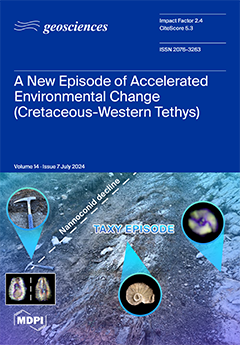Open AccessArticle
Elemental Geochemistry on Paleoenvironment Reconstruction: Proxies on Miocene-Pliocene of Marine to Fluvial Sediment in Serpong, Banten, Indonesia
by
Heri Syaeful, Syaiful Bakhri, Budi Muljana, Agus Sumaryanto, I. Gde Sukadana, Hendra Adhi Pratama, Adi Gunawan Muhammad, Ngadenin, Frederikus Dian Indrastomo, Roni Cahya Ciputra, Susilo Widodo, Nunik Madyaningarum, Puji Santosa, Muhammad Burhannudinnur and Zufialdi Zakaria
Cited by 1 | Viewed by 2753
Abstract
Research of the depositional environment using geological mapping, petrography, gamma-ray (GR) log, palynology, and foraminifera fossils of the Bojongmanik Formation has led to the formation of several different conclusions about the transition to the marine environment, which are attractive to revisit. The expected
[...] Read more.
Research of the depositional environment using geological mapping, petrography, gamma-ray (GR) log, palynology, and foraminifera fossils of the Bojongmanik Formation has led to the formation of several different conclusions about the transition to the marine environment, which are attractive to revisit. The expected results of this research are to determine the paleoenvironment of the Bojongmanik and Serpong Formations based on elemental geochemistry, the development of paleoenvironment proxies based on portable X-ray fluorescence (pXRF) in fluvial to transitional environments studies, and the contribution of paleoenvironment analysis to GR-log facies interpretation. The research methodology starts with GR-log facies analysis, Pearson’s correlation, paleoenvironment analysis based on elemental affinity and elemental ratio, and comparing the paleoenvironment with GR-log-based facies. The paleoenvironment analysis based on elemental geochemistry resulted in the Bojongmanik Formation in the research area deposited at the tidal point bar, lagoon, and shoreface, while the Serpong Formation was deposited at the fluvial point bar and floodplain. Compared to previous research, the Bojongmanik Formation in the research area could be stratigraphically related to the upper Bojongmanik Formation. Proxies based on elemental geochemical affinities of carbonate-associated, carbonate-productivity, terrigenous-associated elements, and redox-sensitive trace elements show contrast changes between facies. Proxies based on the specific ratio show a detailed paleoenvironment for paleoclimate (Sr/Cu), paleosalinity (Sr/Ba), paleoredox (Cu/Zn), paleo-hydrodynamics and water depth (Zr/Rb and Fe/Mn), sediment provenance (Cr/Zr), and siliciclastic-dominated (Zr + Rb)/Sr. Adding a geochemistry element-based paleoenvironment analysis benefits from a more specific justification for GR-log facies interpretation.
Full article
►▼
Show Figures





